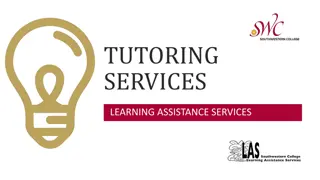Understanding Peer Tutoring: Definition, Types, and Objectives
Peer tutoring is a collaborative learning approach where students of similar or different ages help each other learn. It involves one student instructing another in a subject where the former is knowledgeable and the latter is not. The primary objectives of peer tutoring include enhancing students' knowledge, skills, and communication abilities, fostering social interactions, and building confidence. Two main types of peer tutoring are incidental and structured, each serving different purposes in educational settings. By following specific steps, educators can effectively implement peer tutoring to facilitate cooperative learning environments.
Download Presentation

Please find below an Image/Link to download the presentation.
The content on the website is provided AS IS for your information and personal use only. It may not be sold, licensed, or shared on other websites without obtaining consent from the author. Download presentation by click this link. If you encounter any issues during the download, it is possible that the publisher has removed the file from their server.
E N D
Presentation Transcript
PEER PEER TUTORING TUTORING Course-1.2.3(1st), Unit-2 Ratna Biswas (Asst. Prof. in History)
MEANING OF PEER TUTORING The word peer means a person who belongs to the same age group or social group as someone else especially based on age, grade or status. Example : A peer is someone at your own level. If you are a 10th grader, other 10th grader high school students are your peer. Peer Tutoring: Process between two or more students in a group where one of the students acts as a tutor for the other group-mate(s).Can be applied among students of the same age or students belonging to different age group.
DEFINATION AND OF PEER TUTORING Definition According to Domon and Phelps, Peer tutoring is an approach in which one child instructs another child in material on which the first is an expert and the second is a novice.
OBJECTIVES OF PEER TUTORING (a) Develop students knowledge, skills and abilities. (b) Provide practical opportunity for peer tutors to apply their knowledge and skills in a cooperative learning environment (c) To make the students social and make the community better through co-operative working. (d) Provide a student-centered, non-traditional and innovative learning experience for students. (e) Develop students communication skills through peer tutoring. (f) To make the individuals generous and have helping attitude. (g) To help the student have more and more confidence. (h) To make the habit of consulting each other and solve the problem. (i) To enable the student think and work independently.
TYPES OF PEER TUTORING 1. Incidental Peer Tutoring: Incidental peer tutoring often takes place, either at school or while students are playing after school or when they are socializing. Whenever children are cooperating, playing or studying and one guides the others, it may be stated that we have a kind of incidental peer tutoring. For example when a students asks his/her classmate to help him/her in maths or asks for tips on how to improve his/her performance while playing a new video game, we have cases of incidental peer tutoring. 2. Structured Peer Tutoring: Structured peer tutoring refers to peer tutoring implemented in specific cases and for specific subjects, following a well-structured plan prepared by the teacher. Structured peer tutoring is spontaneously used by experienced teachers who are able to plan well in advance and are familiar on how to combine tutors and tutees appropriately in order to have good results.
STEPS OF PEER TUTORING Step 1 Select the lesson that you consider convenient for you to implement peer tutoring. Step 2 Make any necessary rearrangements of your time schedule in order to be able to proceed with the activity in the selected subject. Step 3 Set up... groups of students for the subject you want to teach. Step 4 Select the peer tutor for each group and design activities. Step 5 Develop special modules and worksheets for students if necessary. Step 6 Describe in general the way you decided to work and the activities you designed. Step 7 Supervision and Evaluation
ADVANTAGES OF PEER TUTORING The following are the advantages of peer-tutoring learning : 1. Peer tutoring gives students an opportunity to use their knowledge. 2. Both tutors and tutees gain self-confidence. 3. The tutor by seeing self competence in his or her ability to help someone. 4. In peer tutoring, the tutee gain positive reinforcement from peers. 5. Peer tutoring develop students knowledge, skills and abilities. 6. In peer tutoring students receive more time for individualized learning. 7. In peer tutoring, direct interaction between students promotes active learning. 8. In peer tutoring tutor reinforce their own learning by instructing others. 9. In peer tutoring, students feel more comfortable and open when interacting with a peer. 10. Peer tutoring provide academic support service. 11. Peer tutoring provide a student-centered, non-traditional and innovative learning experience for students. 12. Peer tutoring provide a training experience that enhances peer tutors professional and intellectual development.
Cont. 13. In peer tutoring students became more and more active. 14. In peer tutoring students develop their communication skills. 15. In peer tutoring the tutee are able to discuss the problems easily with the fellow students and thus their problems at root levels are solved. 16. In peer tutoring students improved their social skills. 17. Peer tutoring can reduce the teacher s burden of responsibility. 18. Peer tutoring provides a learning environment when learners can get immediate feedback on their progress. 19. Peer tutors often have great energy and enthusiasm for what they do because it is a new function for them. 20. Peer teaching is a financially efficient alternative to hiring more staff members.
DISADVANTAGES OF PEER TUTORING The following are the advantages of peer-tutoring learning : 1. Students not taking it seriously because a peer is doing the tutoring and not a teacher. 2. Peer tutoring is very difficult to arrange and manage large number of groups of children. 3. Sometimes it difficult to careful selection to tutors. The success of peer tutoring depends upon mostly on the peer tutor. 4. Sometimes the teacher who arrange the peer tutoring is not sure that tutors are trained. 5. Many time it is seen that there is conflict between the tutor and the learner who needs guidance. It will result into complete failure of peer tutoring. 6. Peer tutoring learning consume times. 7. Peer tutoring can not be used effectively in many situations. 8. In peer tutoring, there may not be good understanding between the two parties.
HOW A TEACHER DESIGNING, DEVELOPING AND IMPLEMENTING PEER TUTORING ACTIVITIES Good Planning . Successful introduction of peer tutoring in class. Careful selection of tutors. Detailed design of tutoring activities. Ongoing Supervision and support for tutors. Utility of the school resources and ICT infrastructure. Keep record of the students activities. Discuss with peer tutors. Discuss with tutees.
References Spencer, V.G. and Babloni, G. (2003). Can students with mental retardation teach their peers?, Education and training in developmental disabilities, Vol38(1), pp-32-61 Tiwari, M. (July 2014). Peer Tutoring A Step Forward Toward Inclusion. Education a Confab, Vol. 3, pp1-17 ISSN: 2320-009X Mortweet, S.L., Utley, C.A., Walker, D. and Ladford, D. (June, 1999) Class wide peer tutoring: Teaching students with mild mental retardation in inclusive classrooms. Exceptional children Vol. 65(4) pp524-536 Neddenriep, C. E., et al., (2009) Class Wide peer tutoring: Two experiments investigating the generalized relationship between increased oral reading fluency and reading comprehension. Journal of applied school psychology. Vol. 25(3) pp 244-269.























